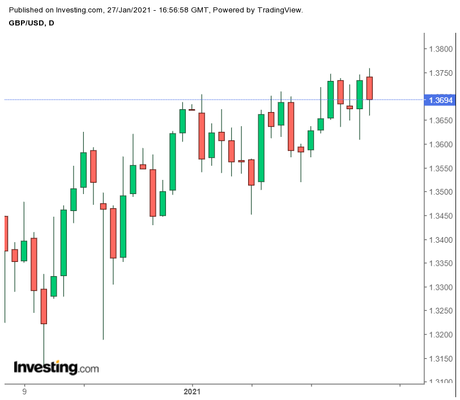The GBP/USD dollar has come down from resistance at 1.3750 on Wednesday, 27 th January, as the unemployment rate touches a 4-year high amid rise in virus cases.

GBP/USD Moves Lower with Unemployment and Coronavirus Infections Higher
UK Finance Minister Rishi Sunak states the pandemic crisis has gone on "longer than we hoped", and the government is supporting businesses, families, and individuals. Employment levels are dropping with the pandemic disrupting supply chains, he says.
COVID infections are surging, and death rates are higher. Active vaccination programs and lockdown are expected to bring the infection rate and death rate down.
The GBP/USD currency pair is unable to breach the strong resistance at 1.3750, for the past few trading sessions. GBP/USD also has strong support at 1.36. As long as the currency pair stays above 1.36, the British Pound will continue to remain in the upward trajectory.

UK Data Report Not as Expected
Unemployment in the United Kingdom is at a 4-year high. The lockdown restrictions are hurting their economy, as many workers and businesses are affected.
The Unemployment Rate in the UK has risen again to 5.0% from 4.9%, moving to the November 2016 high levels. However, they are much better than the expected levels of 5.1%. More than 1.7 million people are unemployed. Earlier in the pre-pandemic times, it was at 4%. Young people are the most affected as they are losing their jobs. The sectors affected are the hospitality sector and the retail sector. Job opportunities are worsening after the pandemic. London and north-east Scotland saw the lowest fall in employment.
The furlough scheme has helped employment in the UK remain strong and is extended until April. The scheme has held back job losses and unemployment in the company.
Retail Sales in the UK MoM indicates consumer spending has improved from -4.1% to 0.3%. It shows that the overall economic activity is improving despite coronavirus infection hurting the economy and has strengthened the GBP. The data reflects that consumer spending has improved with better economic activity.
Average Earnings Index has increased to 3.6% from 2.8%. Claimant Count Change reports that the number of people claiming unemployment benefits has increased to 7,000 in December. The number may further increase with coronavirus strain rising in various parts of the UK say, experts.
The Manufacturing Purchasing Managers Index (PMI) at 59.1 shows expansion in the manufacturing sector. The overall economic performance is good as the Manufacturing PMI is above the 50 levels.
Flash Services PMI is on the uptrend, moving from 54.8% to 57.5%, showing expansion. The service sector is bigger than the manufacturing sector, showing an improvement in the economic output.
The Confederation of British Industry (CBI)'s Survey notes that the retail sector performance has dropped. The percentage of retailers showing an increase in sales has come down and is much lower at -50 than the expected -32 levels, which is not supportive for the GBP.
The Manufacturing Production shows a drop in the total inflation-adjusted value of manufacturing output, which does not augur well for the Sterling.
Vaccination in the UK Outperforms
The vaccine for the coronavirus pandemic is rolled out and almost 10% of the population has received it. The target is for 500,000 vaccines per day. The United Kingdom has outperformed as vaccination is high. The Euro faces supply disruptions, as AstraZeneca's supply has come down 60% in the first quarter.
There are strict border controllers for all traveling to other countries. The US administration has banned flights from South Africa. France and Spain are tightening restrictions again as the new Covid variant is harming the health of citizens.
The economic slowdown will continue through the first quarter of 2021, caused by the infectious coronavirus strain and the lockdown restrictions growing.
US Dollar Index Above 90.00
The US Dollar Index is above the crucial support at 90.00. If it breaks this level, it might move towards 89.75 or head lower, which will strengthen the GBP/USD currency pair.
The Interest Rate decision by the Federal Reserve in the US is expected to move the US Dollar Index stronger or weaker. Changes in the bond-buying program are expected, and it may keep the markets volatile.
In the US, the $1.9 trillion relief plan proposed by the Joe Biden administration faces strong opposition, as they consider the stimulus too large.
GBP/JPY
The British pound faces stiff resistance at the ¥142.50 level. The GBP/JPY has not been able to move past this level for the past two weeks. The second lockdown had brought the currency pair lower.
GBP/INR
The British pound remains volatile and unable to breach the 100.30 level on the upside. The GBP/INR had breached the psychological level at 100.00 levels.
AUD/USD
The Australian dollar moved lower with strong numbers from China and Australia. Retail sale numbers and PMI in China are good, which have strengthened the Australian dollar.
EUR/USD
The EUR/USD currency pair grew weaker ahead of the FOMC meeting. The currency pair fell from the day's high at 1.2170 and moved lower to 1.2090 levels on Wednesday. On Monday, the EUR/USD currency pair moved higher with new plans from the Biden administration to push the supply of coronavirus vaccines.

